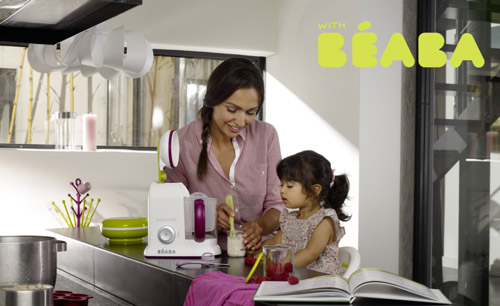Baby Corner


During the first few months of life, babies get all the nutrition they need from breast-milk or formula. But between 4 and 6 months, solid foods need to be introduced. This can be a scary process! Worries about picky eaters, potential allergies, and malnutrition can stop new mothers in their tracks.
We have developed this corner to help you out! With tips, advice, how-to's and resources to help you navigate your way through Baby's first foods, you will soon become adept at overcoming any obstacle in the kitchen that Baby throws at you!
![]()
Why now?
At around 6 months, Baby's nutritional needs change. Breast-milk or formula alone will no longer give him all the nutrients he needs to grow healthy and strong. His biological reflex to suck will change to a swallowing motion, and his digestive system will become more developed, capable of absorbing nutrients from solid foods. It is always best to wait until at least 4 months of age to start introducing solid foods, as food allergies are more likely to develop when solids are given before then, though most doctors will recommend to wait until 6 months of age.
What if my baby doesn't want to eat solid foods?
Each baby is different. While some enjoy discovering new foods, others are not as happy about it. Take into account his mood, and if he refuses something, respect it. If you force him, he will only become more opposed the next time. You can try again with that particular food in a few days. After of couple of tries, babies usually become more comfortable with the change and start eating the new food. Be careful to only introduce one new food at a time; this way you can monitor if he has any allergies or bad reactions.
Here are some tips for introducing new foods:

- Let your baby examine the food before trying to feed it to him.
- Introduce the spoon first. Once he is used to the spoon, you can start feeding him solids.
- Feed him at his own pace. You wouldn't want to be force fed, either!
- If he is capable, allow him to feed himself.
- Don't feed him once he is full. He'll usually turn away or start to get upset if you force him to eat after he is done. Respect his appetite.
- When first introducing solid foods, he might be nervous. Some cuddles and kind words will go a long way!
- Make sure that the food is smooth enough for him to swallow. You don't want him to choke!
- Milk should remain the main staple of your baby's diet. Wean him slowly off of his bottles. By 8 months, you should be feeding him 4 meals a day - with at least 2 bottles of milk and 2 solid meals.
- Make sure that your baby is getting at least 2 cups of milk or formula a day. If he refuses formula, you can supplement with yogurt or other dairy products like cottage cheese, if he tolerates dairy.

Which vegetables are best?
Baby stomachs can easily handle green beans, the white part of leeks, seedless and skinless zucchini, carrots and spinach. Foods with high fiber are harder for them to swallow, such as salsifies and the green part of leeks.
Veggies should be cooked either through steaming or boiling, without any added salt.
Mixing several veggies together is a good idea once your baby has gotten used to eating vegetables, as it gives your little one a larger variety of nutrients.
See our Top 10 Veggies for Babies list for ideas and recipes! There you'll find how-to's for making sweet potatoes, broccoli, and other nutritious veggies for your cutie-pie!
Should I feed him meat, fish, and eggs?

Meat, fish and eggs are a great source of iron, a necessary mineral that all growing babies need. All meats are okay to give to your baby as a puree, except for giblets, pork rinds and cold cuts.
You can feel free to do the same with any fish, except for fish sticks. Just watch out for small bones.
If you want to give your baby eggs, they have to be hard boiled. Make sure you cut them up into itty-bitty pieces or mash them. Keep Baby's diet varied to avoid missing any vitamins or minerals! You can also slowly increase the portion sizes as your baby grows.
Here are some easy recipes to get you started:
Ham and Potato Puree for Babies 6+ Months
Fish, Fennel, and Broccoli Puree for Babies 9+ Months
Lamb, Artichoke, Bell Pepper and Mint Puree for Babies 9+ Months
Should I give him fruit and fruit juice?

Fruit juice is not a necessary supplement to your baby's diet. Nowadays, since formulas and baby foods are fortified with minerals and vitamins, fruit juice is no longer used to complement a baby's diet. It has very little nutritional benefit, and is actually advised against for babies younger than 4 to 6 months.
Fruit can be introduced during an afternoon meal, in addition to Baby's ususal milk. Fruits can be served as a puree, either from raw or cooked fruits. Don't add any extra sugar, as Baby will crave the sugar and start to develop cavities.

Do I need to give him any healthy fats?
A teaspoon of olive oil, butter or organic vegetable oils are great once a day (ideally mixed into the afternoon meal). Never use frying oils, and wait until your baby is at least 6 months old before introducing these fats.
Sample Menus
We've created some sample menus to help you put together all of this new information! Check them out here!
To see all of our baby recipes, click here.
Products We Recommend
Beaba Baby Cook

More steaming articles
Chef Tips and Tricks
This Gluten-Free Broccoli Pizza is original, healthy and super tasty!
ingredients
- 1 head broccoli
- 1 egg
- 1 ¾ cups of your favorite shredded cheese (we recommend two types- 1 cup of one, ¾ cup of the other)
- 1 cup tomato sauce (or canned crushed tomatoes)
- ¾ cup shredded cheese
- ½ cup grated Parmesan
- 9 slices coppa ham
METHOD
- Cut the broccoli and boil until soft.
- Place the broccoli in a blender.
- In a bowl, add an egg and ¾ cup of shredded cheese, mix until solid.
- Form a ball and roll it flat on an oven tray.
- Bake in the oven for 20 min at 350° F.
- Once out of the oven, spread the tomato sauce evenly on the broccoli crust.
- Layer 1 cup of shredded cheese.
- Place a layer of Coppa ham.
- Top off with of grated Parmesan cheese.
- Slide it back into the oven until the cheese melts.
- Serve!


 Sample Baby Menus
Sample Baby Menus
 10 amazing ways to make scrambled eggs...
10 amazing ways to make scrambled eggs...
 Recipe Card Series - Meatballs
Recipe Card Series - Meatballs
Comment on this article
What a handy tool! The photos are so cute :)
Commented by happylady